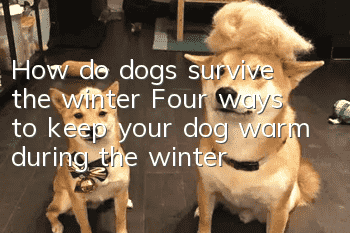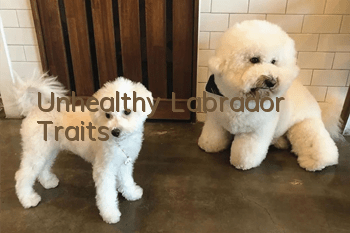How do dogs survive the winter? Four ways to keep your dog warm during the winter

The Vulnerability of Dogs
Understand the specificities of your dog’s breed. Some dog breeds are more sensitive to cold than other dogs, while some dogs can adapt to the cold winter very well:
Dog breeds such as Alaskan Malamutes and Chow Chows also do well in winter.
It is much more difficult for Doberman pinschers, toy dogs, greyhounds, short-haired dogs and hairless dogs to adapt to the cold. Keep them indoors if you can! Any dog that has been shorn should be placed in this category, as their thick coat provides protection against the cold winter weather.
Provide suitable accommodation
Provide suitable accommodation. It is of course best if your dog can stay indoors in the winter. At most, he can go out for exercise occasionally and get in touch with nature. This ensures your dog doesn't get cold while you're out or sleeping. Your dog should not be left outside because, unlike some older dogs, they do not have the ability to keep themselves warm in the cold air.
If you have a dog that lives outdoors (such as a sled dog), make sure it has a small home with a bed inside. Fresh straw can provide a suitable insulation layer against the cold coming from the ground in an outdoor small home; [2] You need to make sure to replace the straw bed with new ones frequently.
An outdoor doggy home should have a sloping roof to insulate it from the cold and keep it warm, which is especially important in cold climate areas. [3] When winter rain comes, make sure the door of your dog’s home can protect the nest from rainwater.
When winter gets particularly cold and long, it’s a good idea to bring your outdoor dog inside; even barns and barns are warmer than outdoor dog cabins.
Warm Dog Bed
Make sure your dog’s warm and comfortable crib is in place. A crib is an important tool for keeping a dog warm during the winter months. If your dog is on the ground or somewhere else, take the bed off the ground. You can stuff a crib with blankets and old clothes, which is a great crib and provides great warmth. For an older dog with joint pain, consider a self-heating dog bed.
Clean and make the crib frequently to reduce fleas and bacteria and change the clutter.
For certain breeds and situations, you can dress your dog in dog clothes. Dog clothing can help your dog stay warm in the winter, especially for puppies, toy breeds, short-haired breeds (such as whippets and greyhounds), and older dogs. [5] One sign of a cold dog: shivering. This is the same as humans. [6] You can buy or make dog jackets, dog thermal underwear, and sweaters (knit, sew, hook, etc.)For small dogs. During the extra winter months, you might be able to give your dog a raincoat, but make sure it can breathe.
Use baby socks to protect your dog's paws when walking on snow or salt. Salt can irritate your dog's paws, and snow can be freezing cold. Baby socks keep paws warm and protected from salt irritation. However, unless you can train your dog to accept baby socks from an early age, it may be difficult for some dogs to tolerate wearing them. In this case, use positive reinforcement training - put a baby sock on it, feed it something, and then take it off. Repeat every day and gradually increase the number of baby socks until your dog gets used to wearing them.
Learn how to choose a good dog sweater to help you choose a dog sweater yourself.
Groom your dog well
Groom your dog well. Don't cut, shave or shave your dog's hair, because all of a dog's hair is its weapon against the cold winter. It's also important to keep your dog in good shape during the winter, as frizzy, dull coats are less able to withstand wind, snow and winter rain, and they don't keep your dog warm. Keeping your dog groomed during the dry winter can alleviate the dog's dandruff problem.
Only bathing at home will ensure your dog is completely dry before going outside.
Give the hair near the paws a good rest. This will help your dog withstand ice and snow and protect its feet. [9] After a walk outside, check your dog’s paws for cracks, injuries, or any foreign objects. If your dog does not wear baby socks, then you need to carefully clean the dog's paws after every walk to remove salt, snow, and chemicals; chemicals may be toxic, and salt may be irritating. .
When the weather is particularly cold, shorten your walks. Don’t try to walk your dog for as long as you would in warm weather. A shorter walk can also give your dog enough exercise and rest without leaving you and your dog feeling cold.
Keep moving even when you are indoors. Play indoor games with your dog, such as throwing a ball, tug of war, hiding dolls, etc. If it's possible to get them running around the house, that's best. Let them go up and down the stairs to train their flexibility. Remember, if your dog has bone problems, he or she cannot run. Just let them slowly walk up and down the stairs.
When walking your dog in the winter, keep it on a leash. If something happens, such as a snowstorm, an ice plow, or your dog darts into a frozen lake and falls into the water, you can help your dog in danger. Dog.
- What should you pay attention to after deworming your dog?
- Will it really kill people if a dog imitates a wolf's barking?
- How to gain weight if Teddy is too thin?
- Can dogs understand people talking? The answer may surprise you
- How much does a golden retriever cost? Analysis of prices of various golden retriever products
- Why does the Zhou dog not die when it comes to dog dealers? The truth is heartbreaking...
- What to eat if your dog’s hair is dry and dull? Feed more of these hair-beautifying foods!
- How long does it take for Big Pampering to take effect? Will it be affected by the dog’s physical condition?
- What can gray Teddy eat to make it easier for him to lose color? Have you memorized the food choices for gray Teddy to change color?
- Dog’s Anal Gland Inflammation Inflammation of the anal glands needs to be treated promptly!



